In today’s digital world, keeping our mobile communications safe is key. Cyber threats are growing, making gsm cybersecurity a must. To protect your business and personal data, knowing the basics of mobile security is crucial. Understanding gsm cybersecurity is complex. We need a full plan to stay safe. This means knowing the latest threats and using strong protection to boost your mobile security.
By being proactive in gsm cybersecurity, you can keep your mobile communications safe. This article will share expert tips and strategies to improve your mobile security. We’ll also help you future-proof your gsm cybersecurity plan.
Understanding the Foundations of GSM Cybersecurity
To improve GSM cybersecurity, we must first grasp the basics of GSM technology. GSM, or Global System for Mobile Communications, is a standard for mobile phones. Knowing how GSM operates, its strengths, and weaknesses helps spot security risks.
Basic security steps like encryption, authentication, and updates are key to fight cyber threats. These actions help lower the chance of cyber attacks. Network protection is also vital to keep sensitive info safe from unauthorized access.
Introduction to GSM Technology
GSM technology is used by millions globally. It’s crucial to know its workings to find security risks. Key parts of GSM technology include:
- Mobile network architecture
- Communication protocols
- Data transmission methods
Basic Security Principles
Defending against cyber threats needs a solid approach to network protection. This means using strong security like encryption and authentication. These steps help keep sensitive info safe from cyber attacks.

Common GSM Security Threats and Vulnerabilities
GSM security faces many threats and vulnerabilities. It’s key to know these risks to protect ourselves. One big threat is weak encryption methods that hackers can use to steal data. Keeping up with security updates is vital to stop these attacks.
Here are some common GSM security threats:
- Man-in-the-Middle Attacks: Hackers steal information by intercepting messages between two people.
- SIM Card Cloning: Hackers make a fake SIM card to get into someone’s mobile account.
- SS7 Protocol Vulnerabilities: The SS7 protocol has weaknesses that hackers use to intercept calls and messages.
- SMS Interception: Hackers steal personal and financial info by intercepting SMS messages.
Knowing these threats helps us fight back. We can use strong encryption methods and stay current with security updates. By understanding these risks, we can protect ourselves from GSM security threats.
Essential GSM Cybersecurity Protection Measures
To keep GSM networks safe, several key steps are needed. Strong authentication is key to verify who’s accessing the network. This stops unauthorized users from getting into sensitive areas.
Network protection is also crucial. Encryption, like end-to-end encryption, keeps data safe if it’s caught in the middle. Regular updates and patches fix vulnerabilities in the GSM network and devices.
Here are some important steps to protect GSM networks:
- Implementing strong authentication protocols
- Using encryption standards, such as end-to-end encryption
- Conducting regular security updates and patches
- Monitoring the network for suspicious activity
By taking these steps, people and businesses can boost their mobile security and network protection. This reduces the chance of security breaches and keeps sensitive info safe.
| Measure | Description |
|---|---|
| Authentication Protocols | Verifying the identity of users and devices |
| Encryption Standards | Protecting data from interception |
| Network Monitoring | Detecting and responding to security incidents |
| Security Updates and Patches | Fixing known vulnerabilities in the GSM network and devices |
Implementing Real-Time Security Monitoring – GSM Cybersecurity
Real-time security monitoring is key to protecting GSM communications from cyber threats. It uses advanced tools to watch network traffic and device activity all the time. This way, it can spot security breaches right away.
It lets organizations act fast to stop or lessen damage. This keeps sensitive information safe.
Effective real-time monitoring has threat detection features. These features spot and warn about suspicious activity as it happens. This quick action helps avoid data breaches and other cyber threats.
By using real-time security monitoring, organizations can keep up with new cyber threats. They can protect their GSM communications well.
Some main benefits of real-time security monitoring are:
- Improved incident response times
- Enhanced threat detection capabilities
- Increased visibility into network traffic and device activity
To start real-time security monitoring, organizations should:
- Invest in advanced security tools and technologies
- Develop a solid incident response plan
- Keep security teams trained and supported
By being proactive with real-time security monitoring, organizations can safeguard their GSM communications. They ensure sensitive information stays safe. This method includes constant real-time monitoring and advanced threat detection.
| Benefit | Description |
|---|---|
| Improved Security | Real-time monitoring and threat detection enhance security |
| Increased Visibility | Continuous monitoring offers insight into network and device activity |
| Reduced Risk | Quick incident response lowers the risk of data breaches and cyber threats |
Conclusion: Future-Proofing Your GSM Security Strategy
As the digital world changes, it’s key to keep your GSM cybersecurity up to date. Stay alert, use the newest security tools, and learn about new GSM security dangers and how to avoid them.
By using the tips and strategies from this article, you can improve your future-proofing efforts. Remember, keeping your data safe is a never-ending job. It needs constant effort and a focus on staying one step ahead of threats. Make sure to update your GSM security, use strong authentication, and protect your data with top-notch encryption.
It’s also important to have a team that keeps learning and working together. Keep up with the latest in the field, join security discussions, and share ideas with others. This way, you can all stay informed and protect your organization better.
In the end, focusing on GSM cybersecurity and thinking ahead will help your organization stay safe in the digital world. This way, you can protect your assets from new dangers.
FAQ’s
What is GSM cybersecurity?
GSM (Global System for Mobile Communications) cybersecurity protects mobile communications. It keeps data safe from cyber threats on GSM networks.
What are the basic security principles for GSM networks?
GSM networks use encryption, authentication, and updates to stay safe. These steps help fight cyber threats.
What are the common GSM security threats and vulnerabilities?
GSM faces threats like man-in-the-middle attacks and SIM card cloning. SS7 protocol issues and SMS interception are also risks.
What are the essential GSM cybersecurity protection measures?
Key measures include strong authentication and encryption. Network monitoring tools and regular updates are also crucial.
How can real-time security monitoring enhance GSM cybersecurity?
Real-time monitoring watches network traffic and device activity. It helps catch and stop cyber threats quickly.
How can I future-proof my GSM security strategy?
Keep up with security patches and use new technologies. Educate yourself and your team about threats and best practices.
